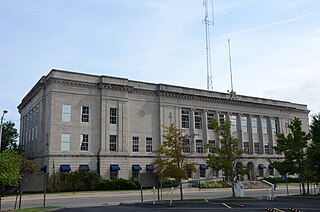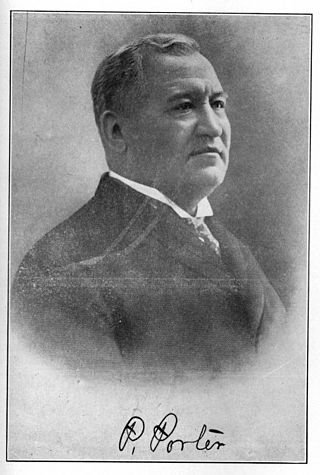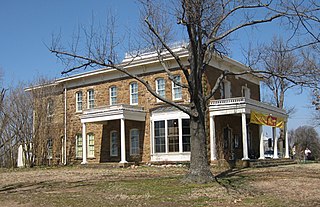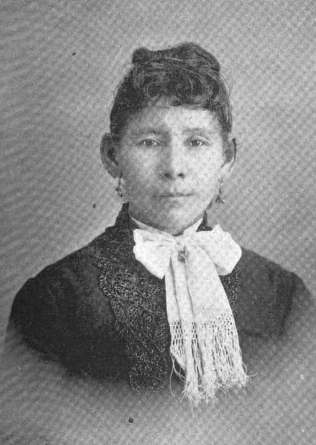
Muskogee County is a county located in the U.S. state of Oklahoma. As of the 2020 census, the population was 66,339. The county seat is Muskogee. The county and city were named for the Muscogee (Creek) Nation. The official spelling of the name was changed to Muskogee by the post office in 1900.

Muskogee is the thirteenth-largest city in Oklahoma and is the county seat of Muskogee County. Home to Bacone College, it lies approximately 48 miles (77 km) southeast of Tulsa. The population of the city was 36,878 as of the 2020 census, a 6.0% decrease from 39,223 in 2010.
The American Dawes Commission, named for its first chairman Henry L. Dawes, was authorized under a rider to an Indian Office appropriation bill, March 3, 1893. Its purpose was to convince the Five Civilized Tribes to agree to cede tribal title of Indian lands, and adopt the policy of dividing tribal lands into individual allotments that was enacted for other tribes as the Dawes Act of 1887. In November 1893, President Grover Cleveland appointed Dawes as chairman, and Meridith H. Kidd and Archibald S. McKennon as members.

Pleasant Porter, was an American Indian statesman and the last elected Principal Chief of the Creek Nation, serving from 1899 until his death.

Henry Laurens Dawes was an attorney and politician, a Republican United States Senator and United States Representative from Massachusetts. He is notable for the Dawes Act (1887), which was intended to stimulate the assimilation of Native Americans by ending the tribal government and control of communal lands. Especially directed at the tribes in Indian Territory, it provided for the allotment of tribal lands to individual households of tribal members, and for their being granted United States citizenship. This also made them subject to state and federal taxes. In addition, extinguishing tribal land claims in this territory later enabled the admission of Oklahoma as a state in 1907.

The United Keetoowah Band of Cherokee Indians in Oklahoma is a federally recognized tribe of Cherokee Native Americans headquartered in Tahlequah, Oklahoma. According to the UKB website, its members are mostly descendants of "Old Settlers" or "Western Cherokee," those Cherokee who migrated from the Southeast to present-day Arkansas and Oklahoma around 1817. Some reports estimate that Old Settlers began migrating west by 1800, before the forced relocation of Cherokee by the United States in the late 1830s under the Indian Removal Act.

The Five Civilized Tribes Museum in Muskogee, Oklahoma, showcases the art, history, and culture of the so-called "Five Civilized Tribes": the Cherokee, Chickasaw, Choctaw, Muscogee (Creek), and Seminole tribes. Housed in the historic Union Indian Agency building, the museum opened in 1966.
Jesse Bartley Milam (1884–1949) was best known as the first Principal Chief of the Cherokee Nation appointed by a U.S. president since tribal government had been dissolved before Oklahoma Statehood in 1907. He was appointed by President Franklin D. Roosevelt in 1941, who reappointed him in 1942 and 1943; he was reappointed by President Harry S. Truman in 1948. He died while in office in 1949.
The Original Keetoowah Society is a 21st-century Cherokee religious organization dedicated to preserving the culture and teachings of the Keetoowah Nighthawk Society in Oklahoma. It has been described as the surviving core of the Cherokee movement of religious nationalism originally led by Redbird Smith in the mid-nineteenth century. After the Cherokee were forced to move to Indian Territory, various groups associated with the Keetoowah Society worked to preserve traditional culture and its teachings.

The Curtis Act of 1898 was an amendment to the United States Dawes Act; it resulted in the break-up of tribal governments and communal lands in Indian Territory of the Five Civilized Tribes of Indian Territory: the Choctaw, Chickasaw, Muscogee (Creek), Cherokee, and Seminole. These tribes had been previously exempt from the 1887 General Allotment Act because of the terms of their treaties. In total, the tribes immediately lost control of about 90 million acres of their communal lands; they lost more in subsequent years.

Alexander Lawrence Posey was an American poet, humorist, journalist, and politician in the Creek Nation. He founded the Eufaula Indian Journal in 1901, the first Native American daily newspaper. For several years he published editorial letters known as the Fus Fixico Letters, written by a fictional figure who commented pointedly about Muscogee Nation, Indian Territory, and United States politics during the period of the dissolution of tribal governments and communal lands. He served as secretary to the Sequoyah Constitutional Convention and drafted much of the constitution for its proposed Native American state, but Congress rejected the proposal. Posey died young, drowned while trying to cross the flooding North Canadian River in Oklahoma.

The Choctaw freedmen are former enslaved African Americans who were emancipated and granted citizenship in the Choctaw Nation after the Civil War, according to the tribe's new peace treaty with the United States. The term also applies to their contemporary descendants.
Creek Freedmen is a term for emancipated Creeks of African descent who were slaves of Muscogee Creek tribal members before 1866. They were emancipated under the tribe's 1866 treaty with the United States following the American Civil War, during which the Creek Nation had allied with the Confederate States of America. Freedmen who wished to stay in the Creek Nation in Indian Territory, with whom they often had blood relatives, were to be granted full citizenship in the Creek Nation. Many of the African Americans had removed with the Creek from the American Southeast in the 1830s, and lived and worked the land since then in Indian Territory.

An Organic Act is a generic name for a statute used by the United States Congress to describe a territory, in anticipation of being admitted to the Union as a state. Because of Oklahoma's unique history an explanation of the Oklahoma Organic Act needs a historic perspective. In general, the Oklahoma Organic Act may be viewed as one of a series of legislative acts, from the time of Reconstruction, enacted by Congress in preparation for the creation of a united State of Oklahoma. The Organic Act created Oklahoma Territory, and Indian Territory that were Organized incorporated territories of the United States out of the old "unorganized" Indian Territory. The Oklahoma Organic Act was one of several acts whose intent was the assimilation of the tribes in Oklahoma and Indian Territories through the elimination of tribes' communal ownership of property.
Wealaka was a community established in 1880 in the Creek Nation, Indian Territory. It is notable as the site of Wealaka Mission, which operated a school from 1882-1907. This school was primarily for Muscogee Creek children, but European Americans could attend for a fee. After statehood in 1907, the site was sold to private owners.
Fred P. Branson was a justice of the Oklahoma Supreme Court from 1926 to 1929, serving as chief justice from 1927 to 1929.
Joseph A. Gill was an American federal judge.
Fort Davis, Oklahoma was established in 1861 on the south bank of the Arkansas River two and one-half miles northeast of present-day Muskogee, Oklahoma to serve as a Confederate States of America headquarters in Indian Territory. The fort's name honored President of the Confederate States of America Jefferson Davis. First called Cantonment Davis, its purposes were to help retain the loyalty of the Indian Territory to the Confederacy and to prevent Union Army invasions into Texas from the north.

Muskogee Yargee Ross was a Creek woman, a prominent pioneer resident of Muskogee, Oklahoma.
Elizabeth Fulton Hester was an American missionary, Confederate States of America nurse, and early suffragette who was active in Indian Territory and later the U.S. state of Oklahoma.









